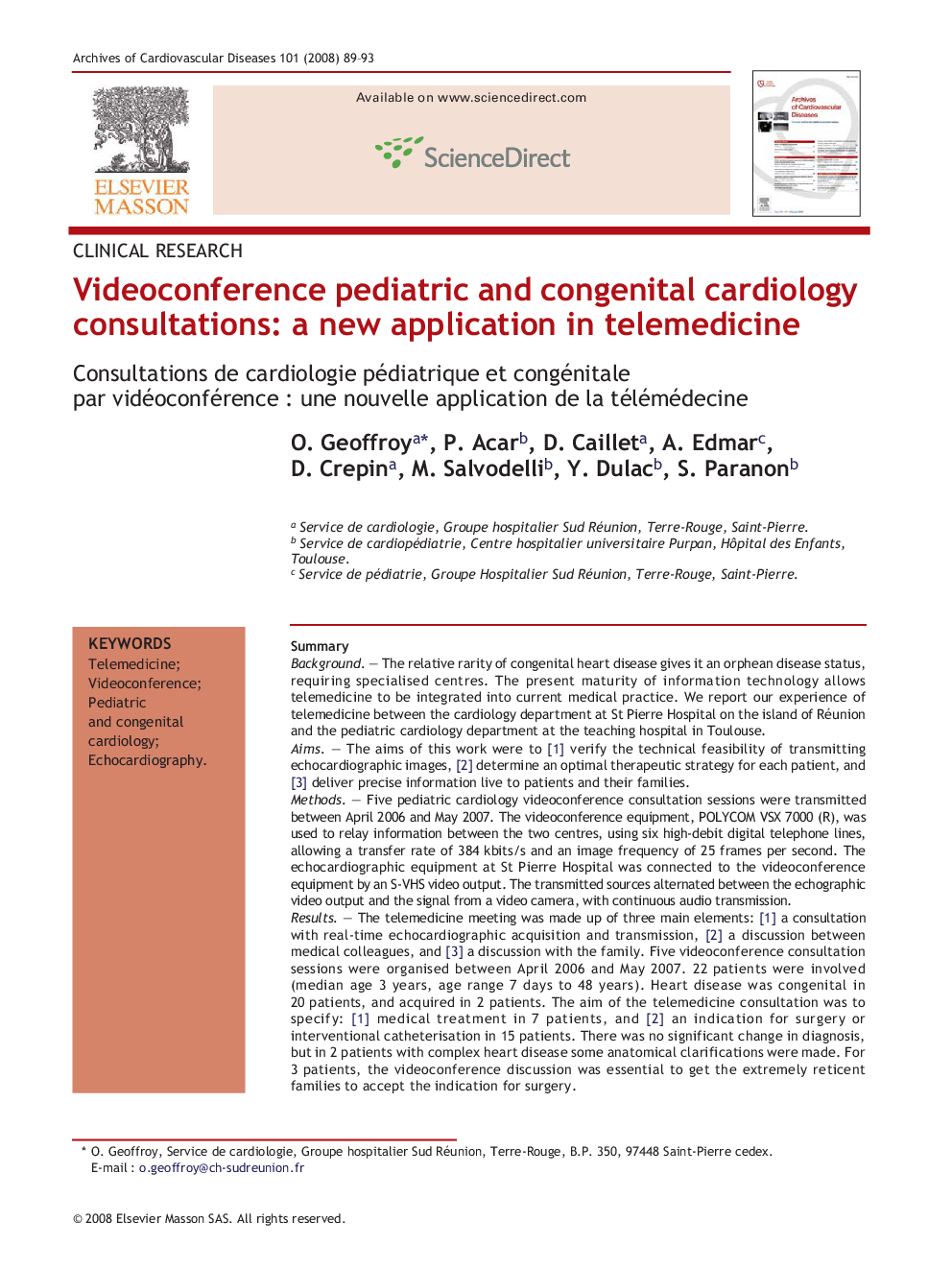| کد مقاله | کد نشریه | سال انتشار | مقاله انگلیسی | نسخه تمام متن |
|---|---|---|---|---|
| 2890045 | 1574418 | 2008 | 5 صفحه PDF | دانلود رایگان |

SummaryBackgroundThe relative rarity of congenital heart disease gives it an orphean disease status, requiring specialised centres. The present maturity of information technology allows telemedicine to be integrated into current medical practice. We report our experience of telemedicine between the cardiology department at St Pierre Hospital on the island of Réunion and the pediatric cardiology department at the teaching hospital in Toulouse.AimsThe aims of this work were [1] to verify the technical feasibility of transmitting echocardiographic images, [2] determine an optimal therapeutic strategy for each patient, and [3] deliver precise information live to patients and their families.MethodsFive pediatric cardiology videoconference consultation sessions were transmitted between April 2006 and May 2007. The videoconference equipment, POLYCOM VSX 7000 (R), was used to relay information between the two centres, using six high-debit digital telephone lines, allowing a transfer rate of 384 kbits/s and an image frequency of 25 frames per second. The echocardiographic equipment at St Pierre Hospital was connected to the videoconference equipment by an S-VHS video output. The transmitted sources alternated between the echographic video output and the signal from a video camera, with continuous audio transmission.ResultsThe telemedicine meeting was made up of three main elements: [1] a consultation with real-time echocardiographic acquisition and transmission, [2] a discussion between medical colleagues, and [3] a discussion with the family. Five videoconference consultation sessions were organised between April 2006 and May 2007. 22 patients were involved (median age 3 years, age range 7 days to 48 years). Heart disease was congenital in 20 patients, and acquired in 2 patients. The aim of the telemedicine consultation was to specify [1]: medical treatment in 7 patients, and [2] an indication for surgery or interventional catheterisation in 15 patients. There was no significant change in diagnosis, but in 2 patients with complex heart disease some anatomical clarifications were made. For 3 patients, the videoconference discussion was essential to get the extremely reticent families to accept the indication for surgery.ConclusionThis is the first experience in France of telemedicine consultation for pediatric and congenital cardiology. These videoconferences allowed patients in the south of Réunion to benefit from a specialist opinion on optimal therapeutic strategy, with no delay or need to travel a long distance.
RésuméJustificationLa relative rareté des cardiopathies congénitales leur confère un statut de maladies orphelines justifiant de faire appel à des centres spécialisés. La maturité actuelle de la télématique permet de façon courante d’intégrer la télémédecine à la pratique médicale. Nous rapportons notre expérience de télémédecine entre le service de cardiologie du CH de St-Pierre de la Réunion et le service de cardiologie pédiatrique du CHU de Toulouse.ObjectifsLe but de ce travail était 1) de vérifier la faisabilité technique de transmission des images échographiques, 2) de déterminer pour chaque patient une stratégie thérapeutique optimale, 3) de délivrer en direct aux patients et leur famille une information précise.MethodesCinq consultations vidéotransmises de cardiologie pédiatrique et congénitale ont été réalisée entre mars 2006 et mai 2007. L’équipement de vidéoconférence, POLYCOM VSX 7000 (R), relai les 2 centres par six lignes Numéris offrant un débit de 384 kbits/s et une cadence image de 25 images par seconde. L’échocardiographe du CH de St-Pierre était raccordé au matériel de vidéoconférence par la sortie vidéo S-VHS. Les sources transmises étaient en alternance la sortie vidéo de l’appareil d’échographie, et le signal d’une camera vidéo, avec transmission audio continue.ResultatsLa réunion en télémédecine se composait en 3 parties : 1) consultation avec réalisation et transmission en temps réel de l’échocardiographie, 2) discussion collégiale médicale et 3) entretien avec la famille. Cinq séances de consultations par vidéoconférence ont été organisées entre avril 2006 et mai 2007. Vingt-deux patients (âge médian 3 ans, âges extêmes 15 jours-48 ans) ont été examinés. Les cardiopathies étaient congénitales chez 20 patients et acquises chez 2 patients. Le but de la consultation en télémédécine était de préciser : 1) la thérapeutique médicale chez 7 patients ; 2) l’indication d’une chirurgie ou d’un cathétérisme interventionnel chez 15 patients. Il n’y a eu aucune modification diagnostique significative mais chez 2 patients avec cardiopathie complexe des précisions anatomiques ont été apportées. Chez 3 patients, la discussion en vidéo-conférence a été essentielle pour faire accepter à la famille très réticente l’indication opératoire.ConclusionLa consultation de cardiologie pédiatrique et congénitale par télémédecine est une 1re expérience en France. Ces vidéoconférences permettent aux patients du Sud de la Réunion de bénéficier d’avis sur la stratégie thérapeutique optimale et ce sans délai ni déplacement.
Journal: Archives of Cardiovascular Diseases - Volume 101, Issue 2, January 2008, Pages 89–93